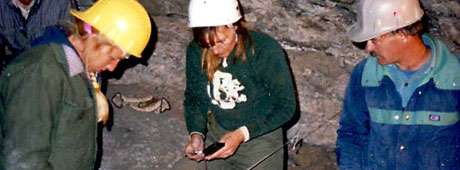No products in the cart.
In Cold Storage

Lava Tubes As Ancient Refrigerators
By Lael Suzann Henrikson
Photos courtesy of Lael Suzann Henrikson
The first time I swallowed my claustrophobia and climbed into Bobcat Cave, I was still in graduate school. The year was 1987, and little did I know that my first steps into the pitch blackness would lead to a mystery that would shape my career. Buried beneath a few inches of dirt, frozen in ice, lay clues about how ancestors of the Shoshone and Bannock people survived the lean times in a challenging landscape.
Now, more than thirty years later, we know that Native Americans used Bobcat Cave and others like it during hot, dry periods spanning the last eight thousand years. A spelunker named Tom Miller first discovered Bobcat Cave in the 1970s near eastern Idaho’s Big Southern Butte, which is southeast of Arco and east of Craters of the Moon National Monument and Preserve. He named the cave after noticing the desiccated remains of a bobcat and her kittens near the entrance—but that wasn’t all he found.
Bobcat Cave also contained signs of use by Native Americans: red ochre “tally marks” on the cave walls, and stone tools and other artifacts scattered across the floor. Richard Hill, an archaeologist with the Bureau of Land Management (BLM), asked my colleagues and me at Idaho State University (ISU) to conduct the first archaeological dig at this site.
He told my professor, Richard Holmer, “I’ve got this bizarre cave. There’s a lot of stuff inside. Would you bring your students and figure out what’s going on?”
This content is available for purchase. Please select from available options.
Purchase Only
Purchase Only

